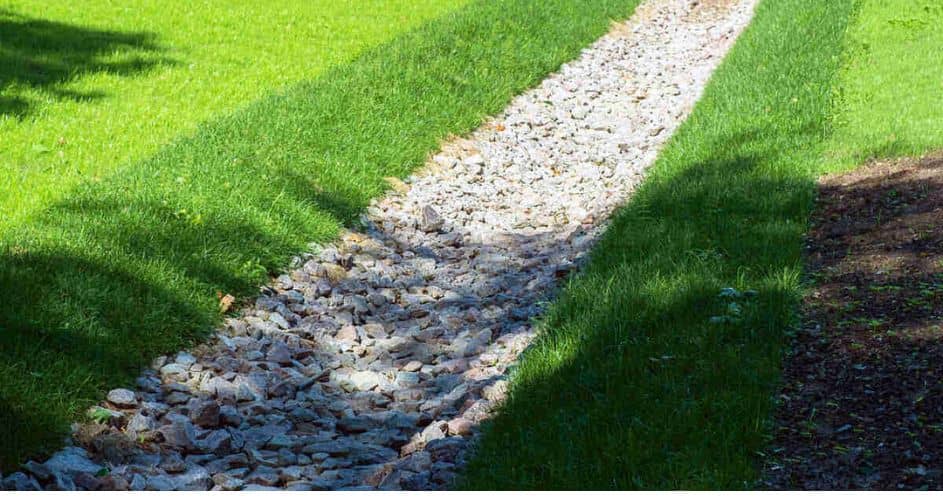
Effectively managing water in your landscape is crucial for protecting your property from water damage and ensuring its structural integrity. One practical and effective solution for this is installing a French drain.
This comprehensive guide will help you by walking you through the step-by-step process of installing a French drain correctly, providing optimal drainage and safeguarding your property.
The Advantages of a French Drain
French drains are invaluable additions to landscapes prone to waterlogging or flooding. They redirect excess water away from structures, reducing the risk of foundation damage.
Additionally, French drains help control soil erosion and maintain the health of your garden by preventing waterlogged areas, making them an essential component in sustainable landscaping.
Necessary Materials for Installing a French Drain
To install a French drain properly, you will need the following materials:
Perforated PVC pipe: This core component channels water away.
Gravel or rock: Facilitates water filtration and flow.
Landscape fabric: Prevents soil intrusion into the gravel.
Shovel or trenching tool: For digging the trench.
Level and measuring tape: For accurate measurements and ensuring a proper slope.
Optional: Catch basin for surface water collection and decorative stones for aesthetic landscaping.
Planning the Route
Before starting the installation process, it’s crucial to plan the route of your French drain. Use stakes and string to mark the path, ensuring the drain slopes away from your home and towards a suitable drainage area. The ideal slope for adequate drainage is about a 1-inch drop for every 10 feet of length.
Digging the Trench
After you have planned the route, it is time to mark it with stakes and strings to allow you to follow it easily. Then comes the digging.
To dig the trench for a French drain effectively, you should use the right tools, such as a shovel or trenching tool, and determine dimensions based on your landscape, aiming for a consistent width of 6 to 12 inches and a depth of 18 to 24 inches.
Check for utility lines before digging, and maintain a uniform trench while adjusting for turns gradually. Remove debris regularly and check the slope continuously to ensure proper drainage. Dispose of excavated soil responsibly, and consider using heavier equipment like a trencher in challenging soil conditions.
Adding Weed Barrier and Gravel
The weed barrier, typically a landscaping fabric, prevents soil intrusion into the gravel layer, maintaining the separation between the soil and the drainage components.
This separation is crucial because it prevents clogging and ensures the longevity and effectiveness of the French drain system. Conversely, the gravel layer is a supportive and stabilising medium for the perforated pipe while facilitating water filtration.
By creating a permeable layer through which water can easily pass, the gravel prevents water accumulation in the trench and aids in maintaining proper drainage.
To maintain the long-term efficiency of the French drain, line the trench with a weed barrier or landscaping fabric. Afterwards, add a base layer of rock approximately 2 to 3 inches thick.
Installing the Drain Inlet and Pipe
When addressing surface water drainage concerns, the installation process for the French drain involves incorporating a drain inlet at the starting point of the trench. The drain inlet is critical for efficiently collecting and redirecting surface water into the drain system.
Following the placement of the drain inlet, the next step is to lay the perforated PVC pipe onto the prepared gravel bed within the trench. It is essential to ensure that the holes in the pipe face downward to facilitate optimal drainage efficiency. The pipe should be laid evenly along the ditch, covering its entire length systematically.
Filling the Trench
Filling the trench is crucial in installing a French drain, as it serves multiple essential purposes. Firstly, it provides support and stability to the perforated pipe, keeping it in place within the trench.
The gravel filling acts as a filtering layer, allowing water to seep into the pipe while preventing the intrusion of debris and soil. This filtration process is vital for maintaining the long-term efficiency of the French drain system.
With the pipe in place, cover it with additional gravel, filling the trench almost to the top.
Covering with Plants and Landscaping
Cover the top layer of gravel with soil to integrate the French drain seamlessly into your landscape. Leave space for planting grass or other plants, or consider adding a layer of mulch or decorative stones. This not only enhances the appearance of your landscape but also helps prevent soil erosion.
Enhancing the Efficiency of Your French Drain
To ensure the effectiveness of your French drain, consider the following tips:
Ensure proper grading: Use a level to check the slope of the drain as you install it. Proper grading is crucial for water flow.
Select the right location: Place your French drain where water tends to accumulate or where soil saturation is a problem.
Regular maintenance: Periodically check the drain for clogs or debris. Regular maintenance ensures long-term functionality.
Addressing Challenges in French Drain Installation
Installing a French drain may present challenges, such as encountering rocks, roots, or compacted soil. If you face these issues, consider renting heavier equipment like a trencher or seek professional help.
In areas with high water tables or severe drainage issues, consulting with a drainage expert can provide tailored solutions for your specific landscape needs.
Conclusion
By following the steps outlined in this guide and considering the unique aspects of your property, you can effectively install a French drain.
While this project can be a DIY endeavour, don’t hesitate to consult with plumbing professionals for complex installations or for advice on installing a French drain most effectively. With the right approach, you can enhance the health and beauty of your landscape while protecting your property from water damage.